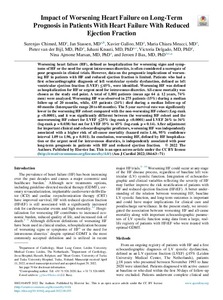Impact of Worsening Heart Failure on Long-Term Prognosis in Patients With Heart Failure With Reduced Ejection Fraction
Chimed Surenjav; Stassen Jan; Galloo Xavier; Meucci Maria Chiara; van der Bijl Pieter; Knuuti Juhani; Delgado Victoria; Marsan Nina Ajmone; Bax Jeroen J
https://urn.fi/URN:NBN:fi-fe2022112968058
Tiivistelmä
Worsening heart failure (HF), defined as hospitalization for worsening signs and symptoms of HF or the need for urgent intravenous diuretics, is often considered a surrogate of poor prognosis in clinical trials. However, data on the prognostic implications of worsening HF in patients with HF and reduced ejection fraction is limited. Patients who had a first echocardiographic diagnosis of left ventricular systolic dysfunction, defined as left ventricular ejection fraction (LVEF) ≤45%, were identified. Worsening HF was defined as hospitalization for HF or urgent need for intravenous diuretics. All-cause mortality was chosen as the study end point. A total of 1,801 patients (mean age 64 ± 12 years, 74% men) were analyzed. Worsening HF was observed in 275 patients (15%) during a median follow-up of 20 months, while, 435 patients (24%) died during a median follow-up of 60 months (Interquartile range 28 to 60 months). The 5-year survival rate was significantly lower in the worsening HF cohort compared with the non-worsening HF cohort (Log-rank p <0.0001), and it was significantly different between the worsening HF cohort and the nonworsening HF cohort for LVEF ≤25% (log-rank p <0.0001) and LVEF 26% to 34% (log-rank p = 0.038) but not for LVEF 35% to 45% (log-rank p = 0.14). After adjustment for important clinical and echocardiographic predictors, worsening HF was independently associated with a higher risk of all-cause mortality (hazard ratio 1.46, 95% confidence interval 1.09 to 1.96, p = 0.011). In conclusion, worsening HF, defined by HF hospitalization or the urgent need for intravenous diuretics, is independently associated with poor long-term prognosis in patients with HF and reduced ejection fraction.
Kokoelmat
- Rinnakkaistallenteet [27094]
